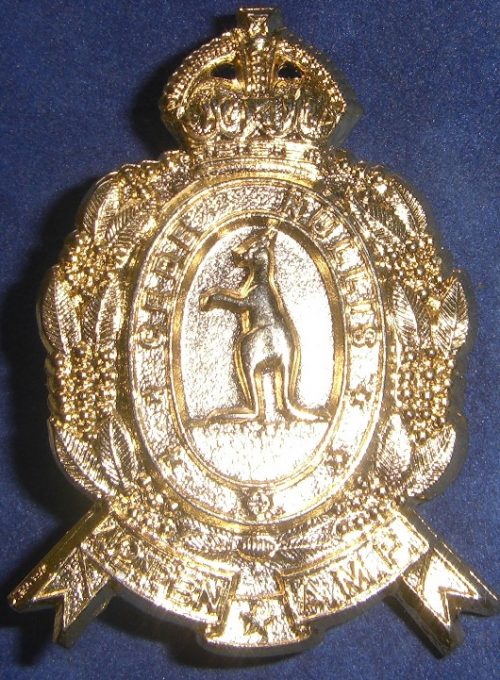Description
Description: 19th Battalion (The South Sydney Regiment) – Oxidised Hat Badge – 1930 to 1942
Maker’s Name: N/A
Condition: Near Mint
Comments: 19th Battalion (The South Sydney Regiment) – Oxidised Hat Badge – 1930 to 1942. Complete with 2 lugs.
Guaranteed to be 100% genuine. Now scarce and highly desirable badge and only worn between 1940 and 1942.
After the First World War the defence of the Australian mainland lay with the part-time soldiers of the Citizens Military Force (CMF), also known as the Militia. The Militia was organized to maintain the structure of the First AIF and kept the same numerical designations. The Militia units were distributed in the same areas the original AIF units were raised. Thus Sydney’s 19th Infantry Battalion was the “South Sydney Regiment”. However, during the Depression little was spent on defence and the Militia had few volunteers. In 1930 the 19th merged with the 1st Battalion, forming the 1st/19th Battalion. The battalion later merged with the 20th Infantry Battalion – the “Parramatta and Blue Mountains Regiment” – and became the 19th/20th Infantry Battalion.
After the start of the Second World War, part of the 19th/20th was transferred from Sydney to the Northern Territory, to help defend Darwin. The element became the “Darwin Infantry Battalion” and was part of the Darwin Mobile Force. The Darwin Infantry Battalion had only a brief history, reverting back to being the 19th in July 1941, separated from the 20th. The 19th remained in Parap in Darwin until September. It was then flown to Sydney, via Brisbane, where it went into camp at Narellan. In January 1943 the battalion moved to Gan Gan, to conduct amphibious training at Shoalwater Bay. In April the 19th moved to Woodford for jungle training. It soon received orders to prepare for “tropical service” and moved to Kuranda on the Atherton Tablelands.
By 1943 the main fighting had moved beyond Papua into New Guinea, leaving the area between Milne and Nassau Bays largely undefended. Consequently, in July the 19th, as part of the 6th Brigade, was sent to the Buna area, where it carried out patrols, laboured on working parties, and performed other garrison duties.
At the end of May 1944 the brigade was transported to New Guinea, first to Lae and then Bulolo in June. The time at Bulolo was considered to be a rest period and in September the battalion was ordered back to Lae. While on the move, the brigade was rumoured to be receiving an operational roll, which was seemingly confirmed at Lae when the brigade received an influx of reinforcements.
The 6th Brigade was originally part of the 4th Division but in New Guinea was placed under the command of the 3rd Division. In the third week of September, the 6th Brigade was allocated to the 5th Division which was scheduled to go to New Britain. Thus, the 6th Brigade was finally given an operational role.
Rather than carry out a major offensive against the Japanese, the much smaller Australian force used active patrolling to confine the Japanese to Rabaul and the Gazelle Peninsula. The 14th/32nd was the first battalion to arrive, landing at Jacquinot Bay, in November. It was followed by the 36th and 19th. The 6th Brigade pushed up the coast by barge and on foot. By the end of February 1945 the 19th had crossed the Mevelo River and was patrolling east to the Wulwut River.
The Japanese had prepared a series of defensive positions on the Waitavalo ridge, overlooking the Wulwut. On 5 March the 19th crossed the river and captured a series of Japanese positions. By mid-March the 19th reached Bacon Hill, on the crest of the Waitavalo ridge and the main Japanese position in the Waitavalo-Tol Plantation area. The 19th was relieved by the 14th/32nd, which captured the hill on 18 March.
With the capture of Bacon Hill, the Australians established a line across the neck of the Gazelle Peninsula. The Australians held the line and patrolled forward for the rest of the war but did not make any major move beyond it into Japanese-controlled territory.
In April, after almost two years in New Guinea and New Britain, the 19th, 14th/32nd, and other units from the 6th Brigade, returned to Australia for leave and further training. But the war was coming to end and the 19th and the 6th Brigade were disbanded in July.








